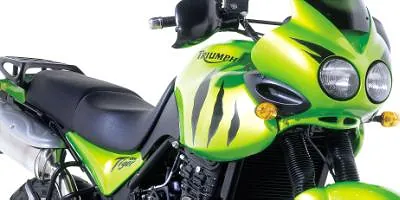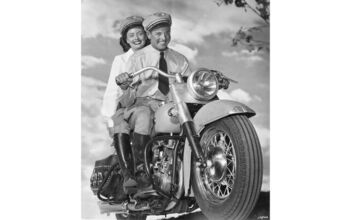Church Of MO: 2001 Triumph Tiger

Man, the Tiger really has come a long way.
On the heels of our review of the 2024 Triumph Tiger 900 family, we thought it was a good time to go back into the archives to see when our first Tiger review was. Turns out it was in 2001 – 22 years ago! Both Triumph and MO have come a long way since then, so re-reading this review is a refreshing glimpse into the past to see not only how far Triumph has come, but us too.
2001 Triumph Tiger - Motorcycle.com
by MO Staff
Lake Elsinore, California, May 4, 2001 -- British people tend to behave differently than we Americans do.
For instance, we like our beer cold while they prefer it at room temperature. We even have entire cities full of queens. They have but one queen, and she is royalty. They even go so far as to call cookies "biscuits" though they can never seem to find a proper country gravy to cover them with.
Not to mention that their "football" is a bunch of pale men running around in their underwear, and then everybody goes out to get bangers and mash which sounds suspiciously like what Hugh Grant got arrested for soliciting.
The British also like their street bikes to look like dirt bikes, something we presumably simple-minded Americans just do not understand. But that's not to say the Euros are wrong, just different. Very different, in fact -- just like Triumph's Tiger.
To sample their new steed, Triumph invited us down to their fleet center in Costa Mesa, California where they were kind enough to provide a 2000 Tiger on hand for back-to-back comparison with the new model on hand. We would spend the day being as British as we dared, and we were determined to have a proper cold ale at the end of the day, mind you. We can only assimilate so quickly, you see. Aside from new graphics, the main change to the 2001 Tiger lies in the motor. Previous versions of the Tiger came equipped with a carburetor-fed 885 cc motor. They soon ditched the carb, though, and fitted fuel-injected to the same motor in the hopes that the small but significant change would appease Triumph's followers. This year, Triumph has equipped the Tiger with not only a new fuel-injection system, but they've attached it to the new 955 cc mill that will be found on the new Daytona.
"The changes within the motor include high-pressure die-cast crankcases, relocated alternator, new closed-loop fuel-injection system, and some small alterations to keep the engine's noise low. The front suspension also received some adjustments that were made to reduce front-end dive during braking maneuvers."
While both the old and new versions feel the same at a standstill, when traveling down the road at an accelerated pace or when engaging in a passing maneuver, the new motor can be immediately appreciated. The 955 cc engine has more top-end power than the old wheezer, while still retaining, if not increasing, the old engine's mid-range and low-end power.
The Ride
Ortega Highway is a smooth stretch of road that stretches from Interstate 5 in Orange County to Lake Elsinore in Riverside County. It's predominantly composed of high-speed sweepers and smooth roads where high-speed cornering stability can be put to the test. However, when engaged in discussions in regard to the Triumph Tiger, high-speed cornering stability is rarely mentioned.
We will make mention of it now, though, since the Tiger possesses excellent stability considering the type of vehicle it is. In essence, the Tiger is a lifted standard-duty motorbike. Equipped with long travel suspension and dual-sport-type tires, it hints at an ability to tackle off-road chores.
However, if our off-road adventures took us onto the beaten path, we'd much rather have a four-stroke motocross bike (like a big-bore KTM, for instance) equipped with street running gear. After our ride over paved roads, things got a bit hairy.
Our route for the day took us through single-lane dirt roads where dirt newbie Hackfu had a chance to see what it's like to slide around on a 500-pound "adventure-tourer." He came away impressed at the stability offered by the bike but lamented its weight. "It's a pretty stable bike, but once the back end starts coming around, it's really difficult to get it straightened out. If it had real knobbies, it would probably help on the dirt." A near head-on collision with an oncoming car proved the Tiger's off-road braking ability. While the brakes are pretty decent on the street, they're really easy to modulate and use on the dirt as well.
During the approximately 300-mile ride, a few things became clear. The three-way height-adjustable seating is a welcome addition and was able to provide an ideal riding position for either highway touring or mountainous sport riding. The windscreen offers good protection up to approximately 80 mph, but after that, it's buffet city, and no, we don't mean the kind of buffet you get in Vegas for a buck-fifty.
Thankfully, for you taller riders, Triumph will offer a larger windscreen as an aftermarket accessory.
Thank goodness for the comfy seat, as the large six-gallon fuel tank will allow you to ride for quite a while. Our own findings were that we are able to ride 150 miles using up approximately four gallons of fuel. One hundred and twenty of those miles were passed with the bike ridden hard. Tone down the riding pace, though, and you should be able to ride in excess of 200 miles. One note of warning is that the fuel gauge is extremely pessimistic. A Triumph representative assured us that we could get another 50 or so miles from the tank even with the needle buried in "E".
Our particular test model was outfitted with the optional side bags. Much like the units from BMW, the bags feature different capacities thanks to the muffler. As Triumph representative Will Tate stated, "Don't put chocolate in the right bag!" The bags are sealed and feature locks on each of the dual latches. Although we'd prefer a single latch mechanism like that of the BMW, the dual latch arrangement worked fine enough. Lane-splitters need not worry, as the bars are the widest part of the bike. The mirrors provide an adequate view but buzzed at highway speeds.
The Verdict
Overall, we came away impressed. By simply upgrading the motor, they made a decent package better. Sure, there are better bikes for long-distance touring, sport riding, and urban-assault-style commuting. But there aren't many bikes that can do all three aspects so well.
2001 Triumph Tiger Specification | |
|---|---|
Engine Type: | Liquid-cooled, DOHC, in-line 3-cylinder |
Capacity: | 955cc |
Bore/Stroke: | 79 x 65mm |
Compression Ratio: | 11.2:1 |
Fuel System: | Multipoint sequential electronic fuel injection |
Ignition: | Digital |
Clutch: | Wet, multi-plate |
Gearbox: | 6-speed |
Frame: | Tubular steel perimeter |
Swingarm: | Twin sided, aluminium alloy with eccentric chain adjuster |
Front Wheel: | 36 spoke, 19 x 2.5in |
Rear Wheel: | 40 spoke, 17 x 4.25in |
Front Tire: | 110/80 H 19 |
Rear Tire: | 150/70 H 17 |
Front Suspension: | 43mm forks with triple rate springs |
Rear Suspension: | Monoshock with remotely adjustable preload/rebound damping |
Front Brake: | Twin 310mm discs, 2 piston calipers |
Rear Brake: | Single 285mm disc, 2 piston caliper |
Length: | 2175mm (85.6in) |
Width: | 860mm (33.8in) |
Height: | 1345mm (52.9in) |
Seat Height: | 840 - 860mm (33.1 - 33.8in) |
Wheelbase: | 1550mm (61.0in) |
Rake/Trail: | 28°/ 92mm |
Weight (dry): | 215kg (474lb) |
Fuel Tank Capacity: | 24 litres (6.4 gal US) |
Maximum Power: | 105PS (104bhp) at 9,500 rpm |
Maximum Torque: | 92Nm (67ft-lbf) at 4,400 rpm |
Become a Motorcycle.com insider. Get the latest motorcycle news first by subscribing to our newsletter here.

Troy's been riding motorcycles and writing about them since 2006, getting his start at Rider Magazine. From there, he moved to Sport Rider Magazine before finally landing at Motorcycle.com in 2011. A lifelong gearhead who didn't fully immerse himself in motorcycles until his teenage years, Troy's interests have always been in technology, performance, and going fast. Naturally, racing was the perfect avenue to combine all three. Troy has been racing nearly as long as he's been riding and has competed at the AMA national level. He's also won multiple club races throughout the country, culminating in a Utah Sport Bike Association championship in 2011. He has been invited as a guest instructor for the Yamaha Champions Riding School, and when he's not out riding, he's either wrenching on bikes or watching MotoGP.
More by Troy Siahaan





























Comments
Join the conversation
2001 wasn't first Tiger test...1997 (with R1100GS). I remember because I bought one. https://www.motorcycle.com/church-of-mo/church-of-mo-1997-adventure-tourers.html